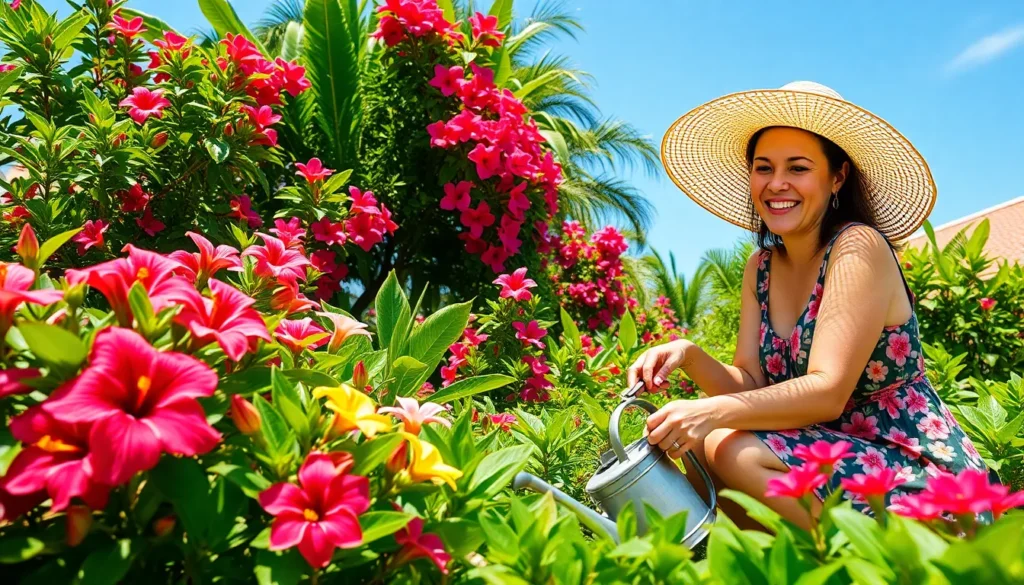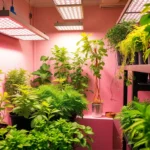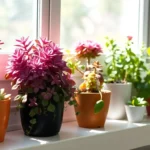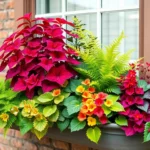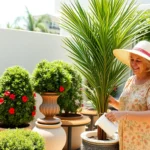We’ve all dreamed of transforming our outdoor spaces into vibrant tropical paradises that burst with color year-round. The secret lies in choosing the right full sun tropical plants that can handle intense sunlight while delivering that lush exotic beauty we crave.
Full sun tropical plants aren’t just stunning to look at – they’re surprisingly resilient performers that thrive in our hottest outdoor conditions. These sun-loving beauties can withstand 6-8 hours of direct sunlight daily while producing spectacular blooms and foliage that’ll make your neighbors stop and stare.
Whether you’re planning a complete garden makeover or simply want to add some tropical flair to your existing industry we’ll show you exactly which plants deliver maximum impact with minimal fuss. Get ready to discover the most gorgeous full sun tropical varieties that’ll turn your yard into an Instagram-worthy oasis.
Understanding Full Sun Tropical Plants and Their Growing Requirements
Full sun tropical plants represent nature’s most resilient and stunning garden performers, designed to flourish in the brightest conditions while delivering spectacular visual impact. We’ll explore the essential growing requirements that make these plants perfect for creating vibrant outdoor spaces.
What Defines Full Sun Conditions
Full sun conditions require plants to receive at least 6 to 8 hours of direct sunlight daily, with optimal growth occurring at 8+ hours of intense solar exposure. We measure light intensity in foot-candles, where full sun areas typically register 8,000 to 10,000 foot-candles during peak daylight hours.
Morning sunlight provides the gentlest introduction to daily light exposure, while afternoon sun delivers the most intense rays between 10 AM and 4 PM. Plants adapted to full sun conditions have developed mechanisms to process and use this high-energy light without experiencing photodamage or heat stress.
Seasonal variations affect full sun exposure, with summer months providing longer daylight periods and more intense rays compared to winter conditions. We observe that south-facing locations receive maximum sun exposure throughout the growing season, making them ideal spots for full sun tropical varieties.
Tropical Plant Characteristics and Adaptations
Tropical plants have evolved specialized features that allow them to thrive in intense sunlight and high-temperature environments. Waxy leaf coatings reflect excess light and reduce water loss, while thick, succulent leaves store moisture for extended dry periods.
Deep root systems anchor these plants while accessing water sources far below the surface, enabling survival during drought conditions. Many tropical species feature silvery or light-colored foliage that deflects harsh sunlight, preventing leaf burn and maintaining optimal photosynthesis rates.
Heat tolerance mechanisms include specialized cellular structures that continue functioning at temperatures exceeding 90°F, where many temperate plants would wilt or cease growth. Rapid growth rates characterize most full sun tropical plants, allowing them to quickly establish strong root systems and lush canopy coverage.
Drought resistance varies among tropical species, with some requiring consistent moisture while others store water in specialized tissues for extended dry spells. We find that flowering mechanisms often trigger during periods of environmental stress, producing spectacular blooms as reproductive survival strategies.
Climate Zones for Tropical Plants
USDA Hardiness Zones 9 through 11 provide the optimal year-round growing conditions for most full sun tropical plants, with minimum winter temperatures rarely dropping below 20°F. Zone 9 experiences occasional frost that may damage tender tropical foliage, requiring protection or container growing for sensitive varieties.
| USDA Zone | Minimum Temperature | Growing Season | Tropical Plant Suitability |
|---|---|---|---|
| Zone 9 | 20°F to 30°F | 8-9 months | Hardy tropicals only |
| Zone 10 | 30°F to 40°F | 10-11 months | Most tropical varieties |
| Zone 11 | 40°F+ | Year-round | All tropical species |
Microclimates within these zones create pockets of warmer or cooler conditions that affect plant selection and placement strategies. Protected areas near buildings or water features often maintain temperatures 5 to 10 degrees warmer than exposed locations, extending the viable growing range for borderline tropical species.
Container growing allows gardeners in cooler zones to enjoy full sun tropical plants during warm months, then move them indoors or to protected areas during winter. We recommend selecting cold-hardy tropical varieties for zones 8 and below, focusing on species that can tolerate brief temperature dips without permanent damage.
Annual growing approaches work well in zones 7 and 8, where full sun tropical plants serve as spectacular seasonal displays that complete their lifecycle during the warm growing season.
Hibiscus: The Classic Full Sun Tropical Beauty
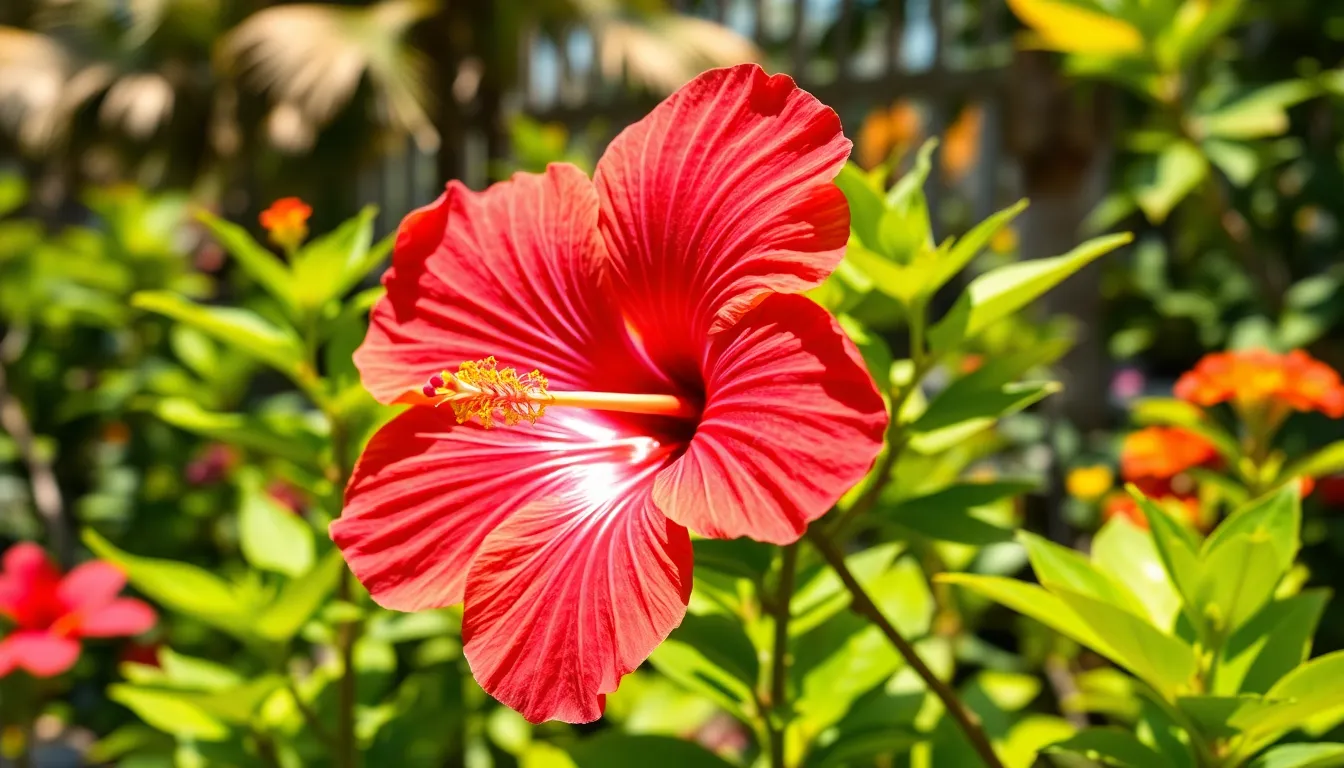
Hibiscus stands as the quintessential full sun tropical plant, delivering those iconic large blooms that instantly transform any industry into a tropical paradise. These stunning plants thrive when they receive at least six hours of direct sunlight daily, rewarding gardeners with vigorous growth and continuous flowering throughout the growing season.
Popular Hibiscus Varieties for Full Sun
Rose Mallow (Hibiscus moscheutos) dominates our list with its impressive adaptability to USDA zones 5-9. This powerhouse variety reaches heights of 3 to 8 feet and produces absolutely massive blooms up to 8 inches wide from early spring through the first frost. We love how it brings authentic tropical flair even to cooler climate gardens where other tropical plants struggle.
Rose of Sharon (Hibiscus syriacus) offers incredible versatility for zones 5-9, thriving in full sun to partial afternoon sun conditions. These plants produce classic hibiscus flowers in vibrant colors, making them perfect companions for other full sun tropical favorites like Dipladenia, Mandevilla, and Ixora.
Tropical Hibiscus varieties excel in zones 9-11, where they can grow as perennials alongside Crotons, Bird of Paradise, Alocasia, and Butterfly Bushes. These combinations create those lush, layered tropical landscapes we see in resort destinations.
Care Tips for Maximum Blooming
Sunlight requirements form the foundation of successful hibiscus growing. We recommend providing at least six hours of direct sun daily to stimulate maximum flower production and maintain robust plant health.
Watering practices should focus on consistent moisture without waterlogging. Keep soil evenly moist but ensure excellent drainage to prevent root rot issues that commonly affect container grown hibiscus.
Soil preparation works best with rich, fertile growing medium enhanced with organic matter. Well draining soil prevents the moisture related problems that can plague these otherwise resilient plants.
Fertilization schedules should include balanced, slow release fertilizers applied throughout the growing season. This approach promotes both lush foliage development and abundant bloom production.
Pruning techniques encourage bushier growth patterns while supporting continuous flowering cycles. Regular deadheading removes spent blooms and redirects energy into new flower development.
Protection strategies become important during extreme weather events, even though most hibiscus varieties show remarkable heat tolerance. Shield plants from strong winds and sudden temperature drops to maintain optimal growing conditions.
Bougainvillea: Vibrant Cascading Color for Sunny Spots
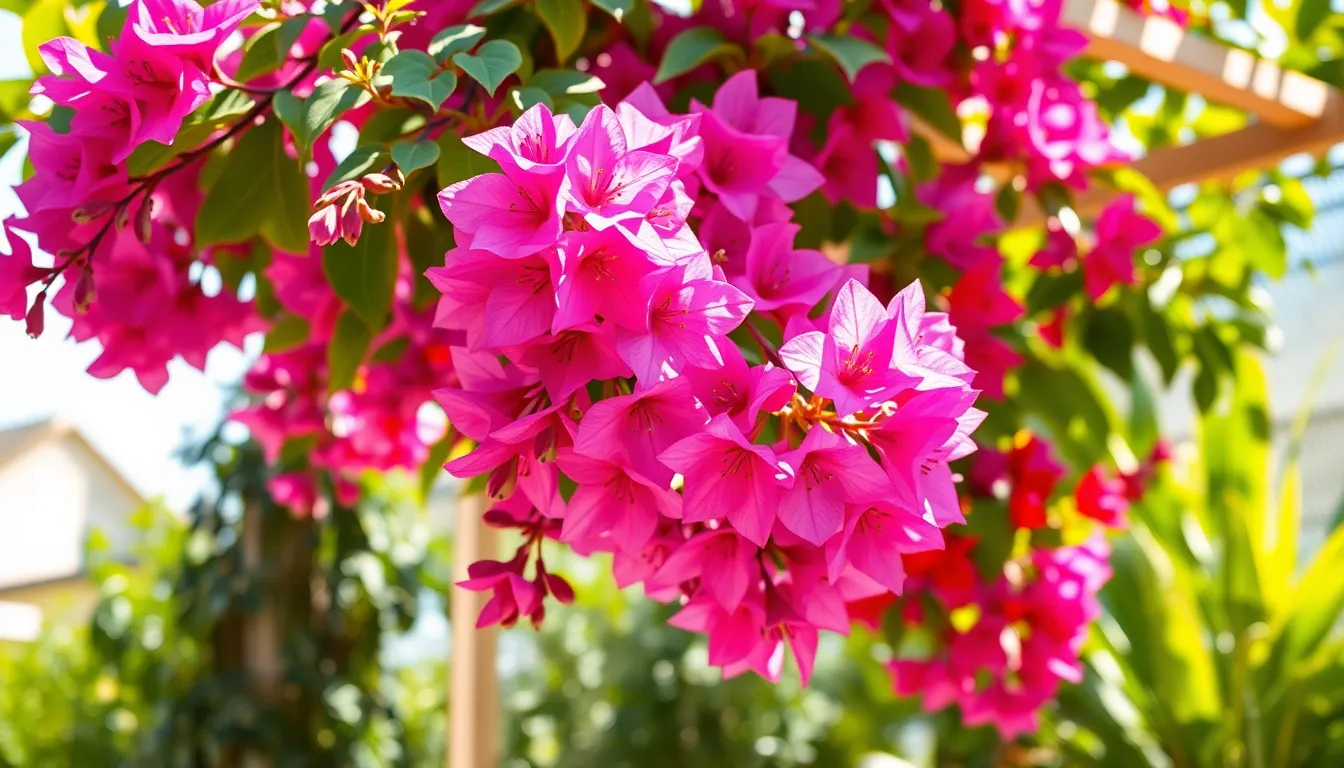
Bougainvillea stands out as one of our most beloved tropical plants for full sun locations, delivering spectacular cascading displays that rival any Instagram-worthy garden paradise. These hardy climbers transform ordinary fences and trellises into living masterpieces with their brilliant papery bracts in stunning shades of pink, purple, red, and orange.
Best Bougainvillea Cultivars for Full Sun
‘Barbara Karst’ tops our list with its intense magenta-purple bracts and remarkably vigorous growth pattern. This cultivar handles the most scorching sun conditions while producing dense clusters of vibrant color that last for months.
‘San Diego Red’ delivers bright red bracts paired with a naturally dense growing habit that creates full coverage. We’ve found this variety particularly effective for covering large wall surfaces and creating dramatic focal points in sunny landscapes.
‘Golden Glow’ brings unique yellow bracts that add brilliant brightness to any tropical garden design. Unlike traditional purple and red varieties, this cultivar offers a fresh color palette that complements other warm-toned tropical plants beautifully.
These three cultivars not only tolerate intense sunlight and heat but actually flourish under these conditions, making them perfect choices for tropical and subtropical regions where full sun exposure is abundant.
Pruning and Training Techniques
Regular pruning encourages denser growth patterns and significantly more abundant flowering throughout the growing season. Light pruning after each bloom cycle removes spent flowers and weak stems, while heavier pruning in late winter shapes the overall plant structure and controls aggressive growth.
Training techniques allow us to transform bougainvillea into various forms including vines, shrubs, or even small trees depending on our garden goals. Trellises, fences, and arbors provide essential support for the plant’s naturally cascading growth habit.
Gentle tying of stems to guide structures helps achieve desired shaping without damaging the plant’s delicate branches. We recommend using soft plant ties or cloth strips rather than wire or hard materials that can cut into the stems.
Strategic placement near sunny walls or structures maximizes both the plant’s health and its visual impact, as bougainvillea responds exceptionally well to training when grown in full sun environments where it can develop its most vibrant colors.
Bird of Paradise: Exotic Architectural Drama
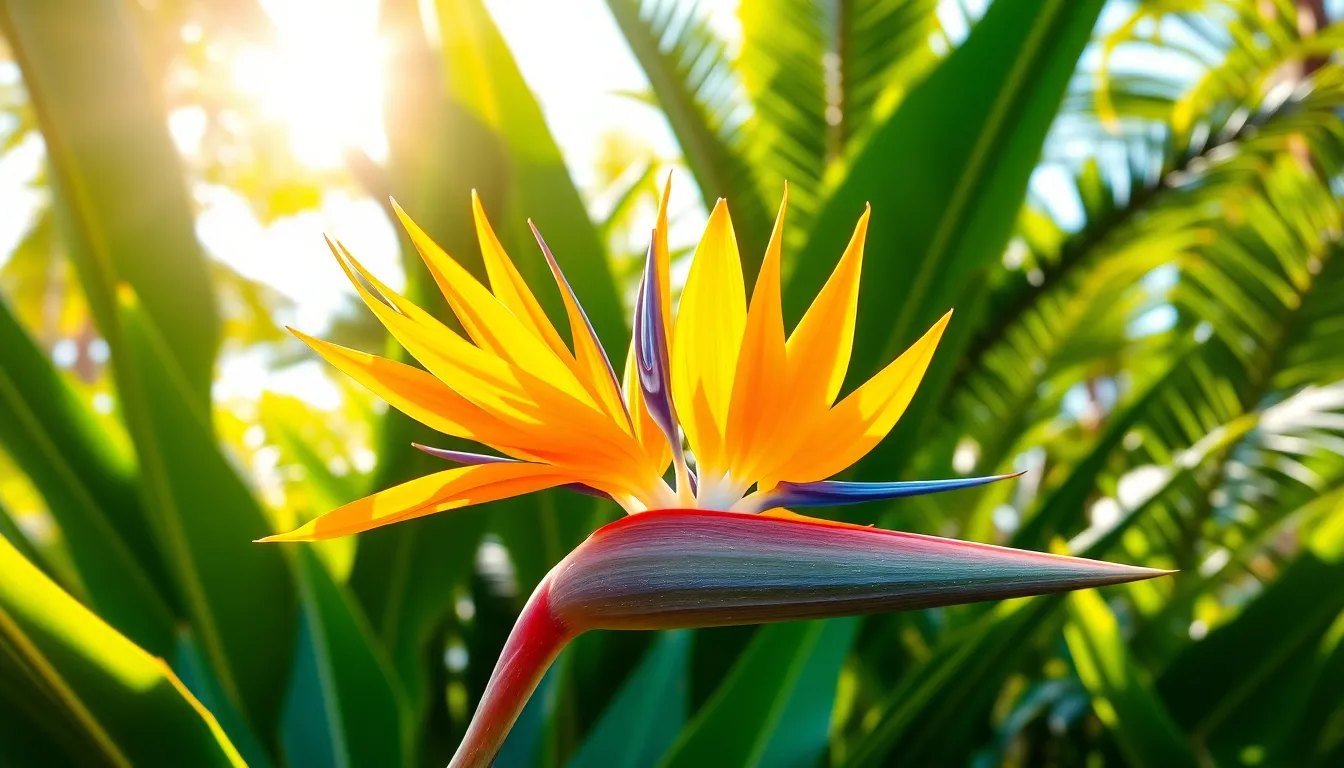
Bird of Paradise stands as the crown jewel of full sun tropical plants, delivering striking architectural form and dramatic flowers that instantly transform any sunny garden into an exotic paradise. This remarkable Strelitzia species thrives in bright, direct sunlight and creates stunning focal points in tropical-themed landscapes.
Strelitzia Varieties for Full Sun Gardens
Strelitzia reginae produces the most iconic orange and blue bird-like flowers that we associate with tropical elegance. This variety reaches 3-5 feet in height and width, making it perfect for borders and container growing in full sun locations.
Strelitzia nicolai grows significantly larger, reaching 20-30 feet in optimal conditions and creating dramatic vertical statements in sunny gardens. We recommend this variety for spacious landscapes where its impressive size can be fully appreciated.
Strelitzia juncea offers a more compact option with striking blue and white flowers and unique rush-like foliage. This variety tolerates slightly less water than other Strelitzia species while maintaining its full sun requirements.
Strelitzia alba produces pure white flowers that create elegant contrast against the typical tropical color palette. We find this variety particularly stunning when planted in groups for maximum visual impact.
Creating Optimal Growing Conditions
Sunlight requirements demand 6-8 hours of full sun daily, including stronger afternoon rays for optimal growth and flowering. Position your Bird of Paradise in the brightest location available to ensure robust development.
Watering schedules must maintain consistent moisture levels throughout warmer months while preventing waterlogging that leads to root rot. We recommend deep, infrequent watering sessions that saturate the root zone completely.
Soil preparation requires well-draining mixtures that prevent standing water around the root system. Use organic compost mixed with coarse sand or perlite to create the ideal drainage conditions these plants demand.
Fertilizing programs should include balanced fertilizer applications during the growing season to boost both growth and flowering. Apply fertilizer every 4-6 weeks from spring through early fall for best results.
Protection strategies include mulching around the base to retain moisture and using windbreaks during strong weather events. Even though Bird of Paradise tolerates intense heat, we protect them from extreme drought conditions and leaf scorch through strategic placement and proper care.
Plumeria: Fragrant Tropical Elegance
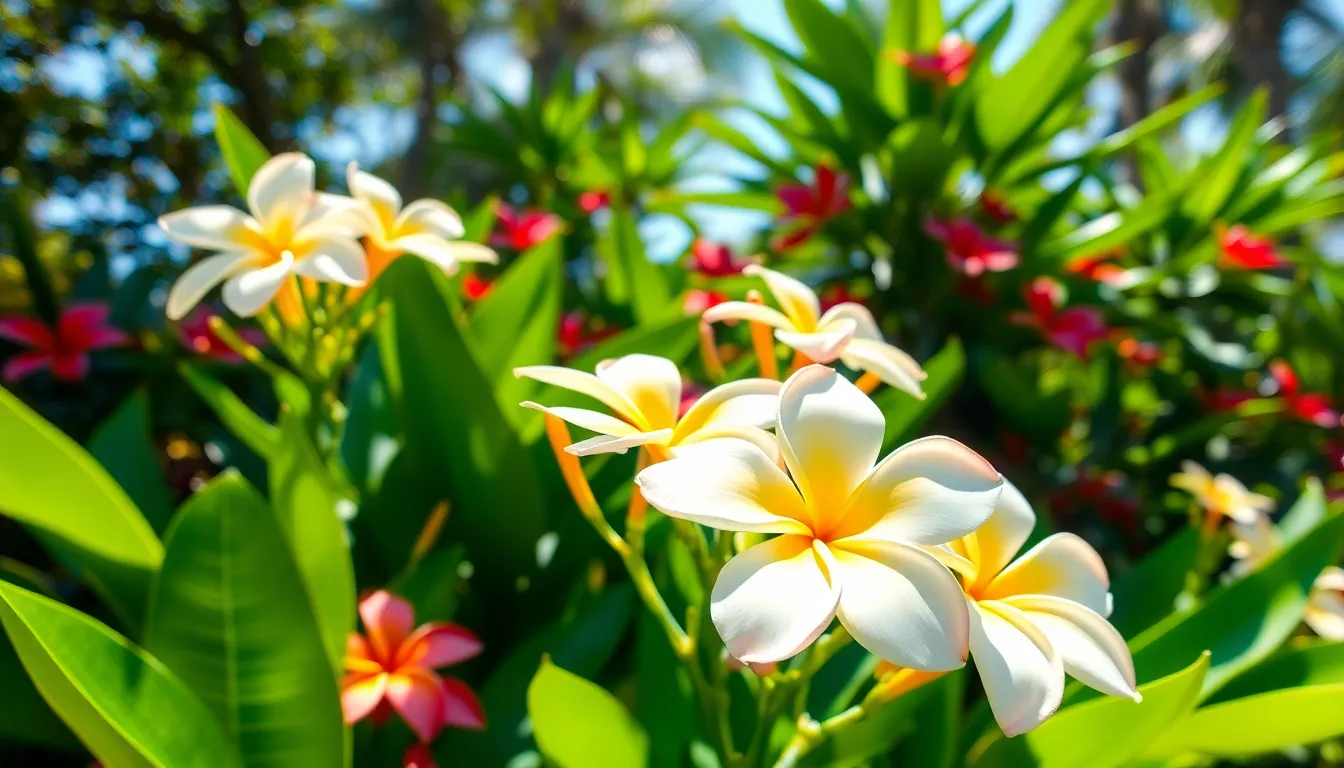
Plumeria stands as one of our most beloved full sun tropical plants, bringing unmatched fragrance and tropical charm to any garden. We’ve witnessed these stunning specimens transform ordinary spaces into exotic havens with their colorful, intensely scented blooms.
Top Plumeria Species for Sun Exposure
Plumeria rubra leads our list of exceptional full sun varieties, producing large, fragrant flowers in an impressive array of colors including white, yellow, pink, and red. This species demands at least 6 hours of direct sunlight daily to achieve its spectacular blooming potential. We recommend this variety for gardeners seeking maximum flower diversity and reliable performance in zones 9-11.
Plumeria obtusa offers another excellent choice for intense sun exposure, featuring glossy leaves and predominantly white flowers with distinctive yellow centers. Heat tolerance makes this species particularly valuable for our hottest garden locations. Protection from frost becomes essential since these plants thrive exclusively in warm climates.
Both species flourish in well-draining soil conditions and require consistent warmth throughout their growing season. We’ve observed that inadequate sunlight dramatically reduces flowering, making full sun positioning absolutely critical for success.
Propagation and Seasonal Care
Spring propagation through stem cuttings provides our most reliable method for expanding plumeria collections. Cuttings root easily in warm soil when taken during spring or early summer months. We recommend allowing cut ends to callus for several days before planting to prevent rot.
Growing season maintenance involves regular watering combined with balanced fertilizer applications to encourage healthy growth and abundant flowering. Summer months require consistent moisture without waterlogging, as plumeria roots are susceptible to rot in soggy conditions.
Winter protection becomes crucial for long-term plant health, especially in marginal zones. We keep plants dry during dormant periods and provide frost protection through indoor overwintering or greenhouse storage in cooler climates. Pruning can shape plants and encourage branching, but we time this carefully to avoid removing developing flower buds.
Container growing offers flexibility for gardeners in zones below 9, allowing us to move plants indoors when temperatures drop. This approach extends plumeria growing possibilities into cooler regions while maintaining the tropical elegance these plants provide.
Croton: Bold Foliage for Tropical Landscapes
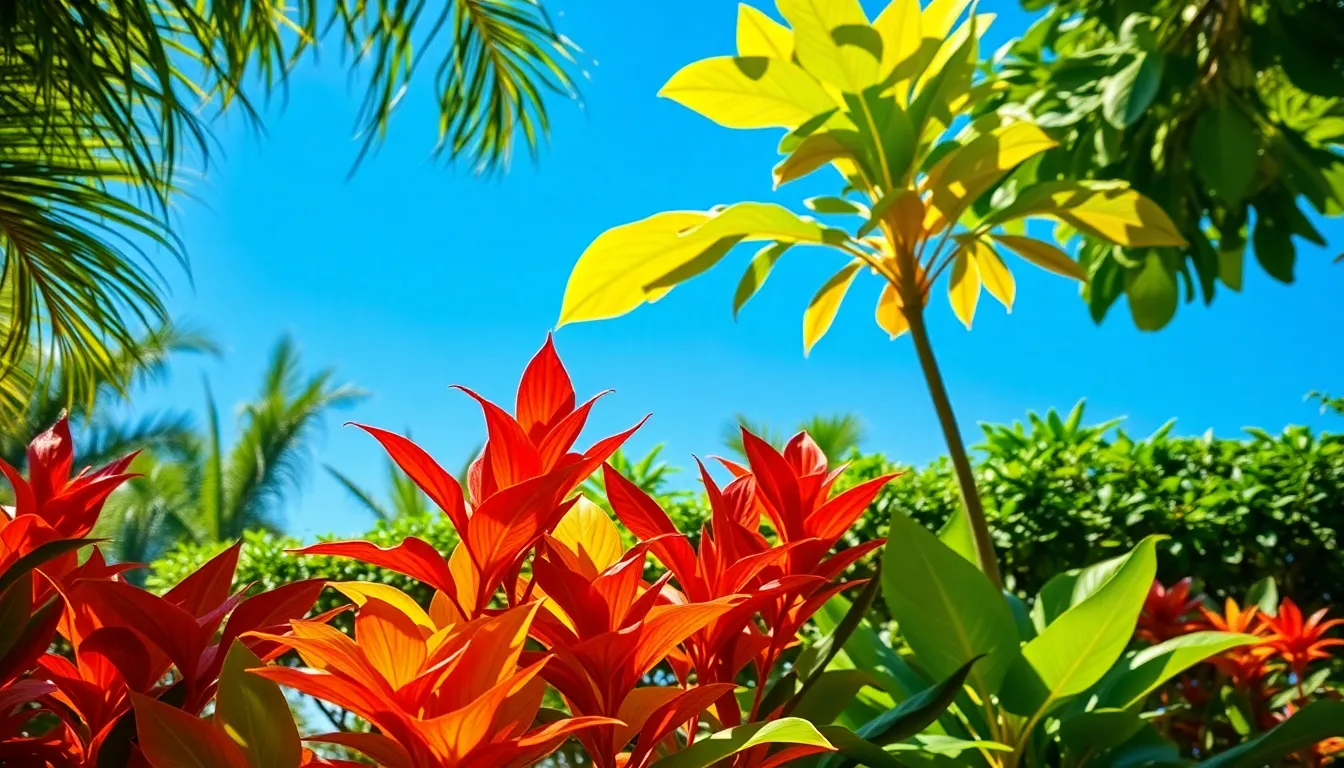
Croton (Codiaeum variegatum) stands out as one of the most striking full sun tropical plants we can add to our gardens. These bold beauties transform any industry with their multicolored foliage that thrives in intense sunlight and high humidity conditions.
Colorful Croton Varieties for Full Sun
‘Petra’ delivers exceptional performance with its broad, oval leaves displaying a stunning mix of reds, oranges, and yellows that intensify under direct sunlight. We love how this variety maintains its vibrant coloration even during the hottest summer months.
‘Gold Dust’ creates eye-catching contrast through its green leaves adorned with bright yellow speckles that shimmer in full sun exposure. This variety works perfectly as a backdrop plant or focal point in tropical garden designs.
‘Mammy’ offers unique architectural interest with its narrow, spiraling leaves featuring red, orange, and yellow hues that become more pronounced with adequate sunlight. We find this variety particularly effective for adding vertical texture to our tropical plantings.
Selection matters significantly when choosing croton varieties for full sun locations, as these exact cultivars have been bred to withstand intense heat while maintaining their spectacular color displays.
Managing Leaf Color and Growth
Sunlight requirements demand at least six hours of direct daily exposure to achieve the brightest and most vivid foliage colors that make crotons so desirable. We’ve observed that insufficient light leads to dull, predominantly green leaves that lack the dramatic color variations.
Soil preparation involves ensuring excellent drainage while maintaining consistent moisture levels to prevent both root rot and leaf drop during dry periods. Well-draining soil allows roots to access oxygen while retaining enough moisture for healthy growth.
Watering schedules require careful balance between preventing drought stress and avoiding overwatering that can damage root systems. We recommend supplemental irrigation during extended dry periods while allowing soil to dry slightly between waterings.
Fertilization supports vigorous growth and color retention when we apply balanced fertilizer regularly throughout the growing season. Proper nutrition helps maintain the intense pigmentation that makes croton foliage so spectacular.
Heat acclimation prevents leaf scorch in extremely intense conditions, though gradual exposure helps plants adapt to full sun environments. We’ve found that properly established crotons become remarkably resilient once they’ve adjusted to their sunny locations.
Lantana: Hardy Butterfly Magnets
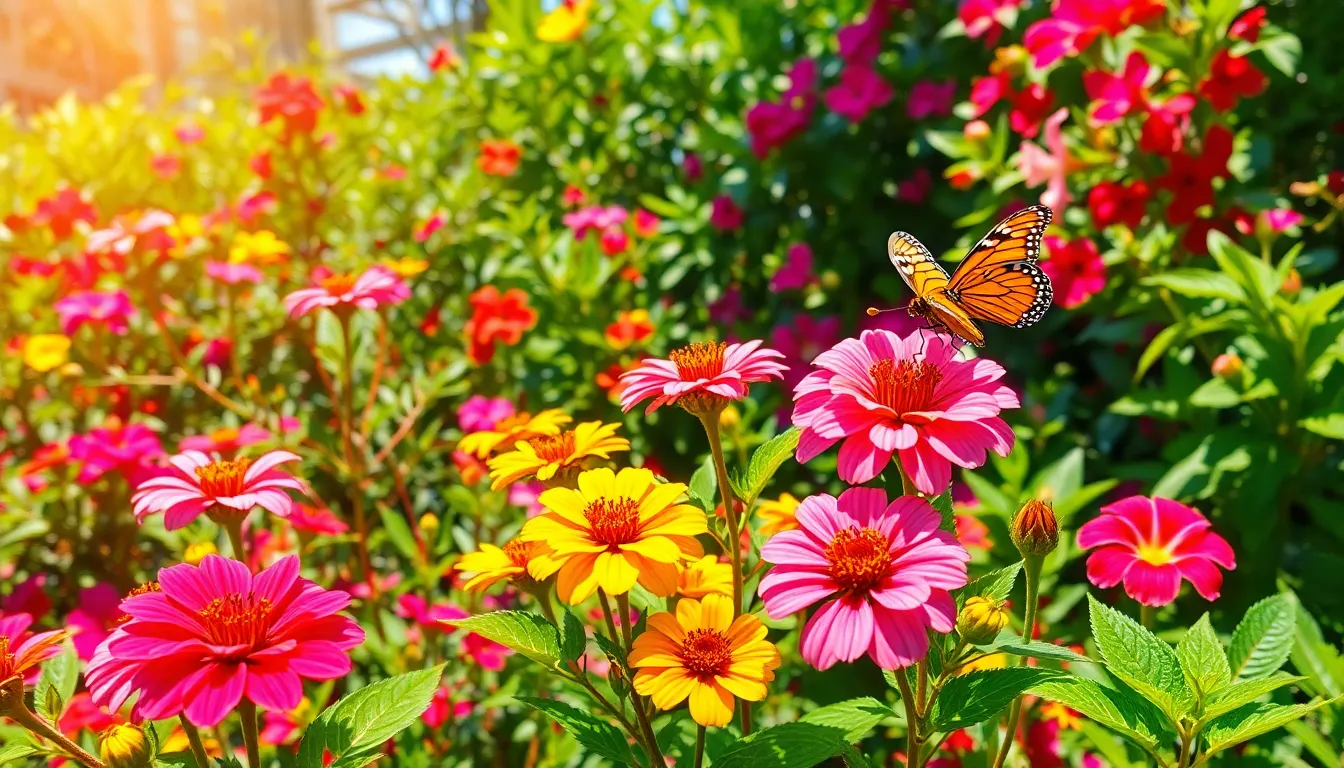
Lantana stands out as one of the most resilient tropical plants for full sun gardens, producing vibrant flower clusters that serve as magnets for butterflies and other pollinators. These hardy perennials thrive in intense heat and drought conditions once established, making them perfect choices for sunny tropical landscapes.
Heat-Tolerant Lantana Cultivars
Selecting the right lantana cultivars ensures your garden maintains continuous color throughout the hottest months. These specially bred varieties have enhanced heat tolerance and ornamental appeal designed for tropical environments.
Cultivars adapted to full sun conditions withstand intense sunlight and prolonged dry spells common in tropical climates. Popular heat resistant varieties include ‘New Gold’ with bright yellow blooms, ‘Radiation’ featuring vibrant orange and red flowers, and ‘Miss Huff’ known for its exceptional cold and heat tolerance.
Breeding programs focus on developing lantana varieties that endure extreme temperatures while maintaining their flowering performance. These enhanced cultivars provide reliable blooms even during the most challenging summer conditions, supporting butterfly populations when other plants struggle.
Performance data shows that heat tolerant lantana cultivars can withstand temperatures exceeding 100°F while continuing to produce flowers. This resilience makes them invaluable for gardeners in USDA zones 9 through 11 where summer heat can be intense.
Companion Planting Ideas
Hardy hibiscus varieties like Hibiscus moscheutos and H. rosa-sinensis create stunning combinations with lantana in full sun gardens. Both plants share similar growing requirements and contribute dazzling colors with their large, showy flowers that complement lantana’s clustered blooms.
Bougainvillea serves as an excellent companion plant with its colorful bracts that flourish alongside lantana in full sun conditions. This evergreen woody vine adds vertical interest while attracting the same pollinators that visit lantana flowers.
Bird of Paradise (Strelitzia nicolai) produces striking orange flowers and grows well in full sun to part shade environments. Its architectural form provides dramatic height variation when planted behind lower growing lantana varieties.
Esperanza (Tecoma stans) offers bright yellow bell shaped flowers that thrive in full sun conditions alongside lantana. This shrub provides continuous color throughout the growing season, creating a vibrant yellow and multicolored flower combination.
Tropical garden designs benefit from layering these companion plants with lantana to create diverse textures and colors. Rich soil, regular irrigation, and mulch applications help all these plants maintain optimal growth even during the hottest periods.
Ixora: Compact Flowering Shrubs for Sunny Borders
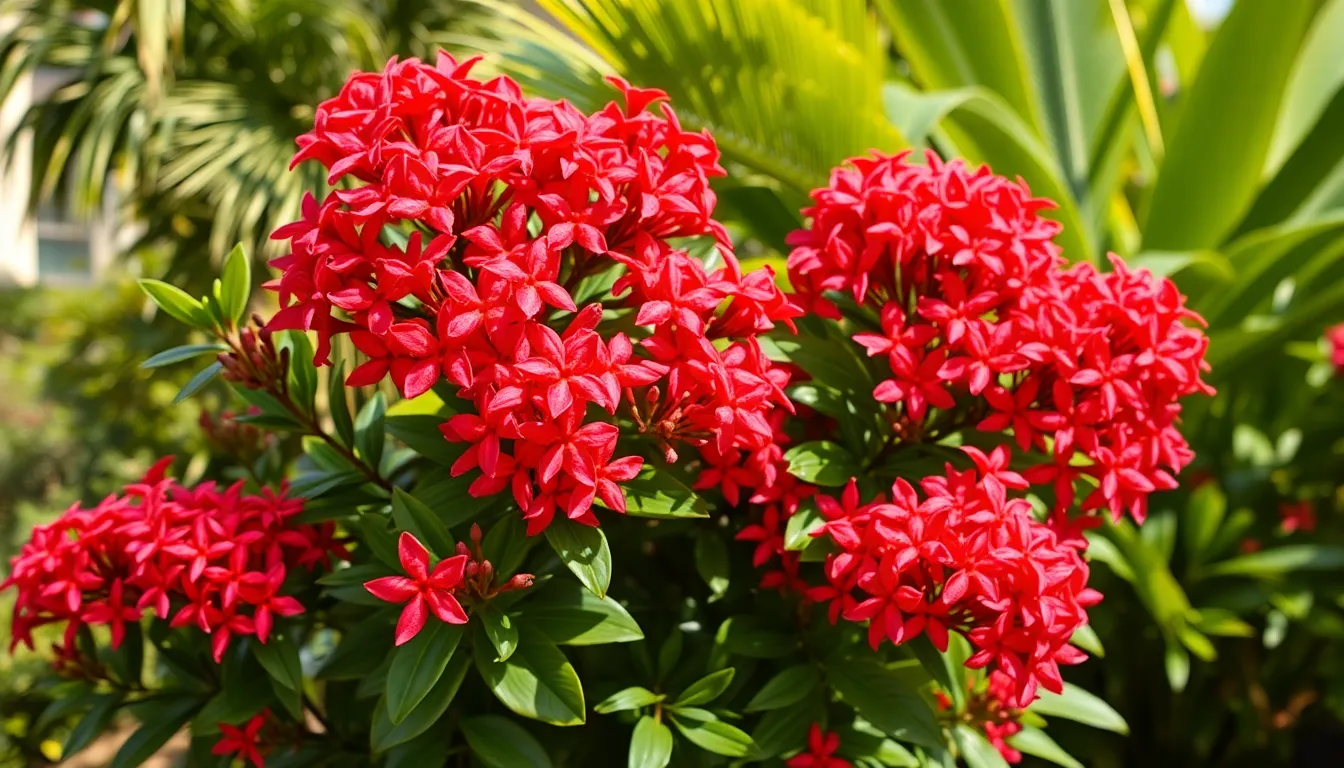
Known for their vibrant flowers and resilience in intense sunlight, Ixora varieties serve as perfect compact shrubs for creating stunning sunny borders in tropical landscapes. These evergreen flowering shrubs offer consistent blooms throughout warm months while maintaining manageable sizes that work beautifully in both small and large garden spaces.
Dwarf and Standard Ixora Varieties
Dwarf Ixora varieties typically reach heights of 2 to 3 feet, making them ideal for front borders and container gardening in sunny locations. Popular dwarf cultivars like ‘Super King’ and ‘Nora Grant’ produce dense clusters of flowers in shades ranging from bright red to coral pink, creating vibrant displays without overwhelming smaller spaces.
Standard Ixora varieties grow between 4 to 6 feet tall, providing excellent mid-border structure while delivering impressive flower power in full sun conditions. Cultivars such as ‘Maui Red’ and ‘Yellow Prince’ offer larger flower clusters and can serve as focal shrubs in sunny tropical gardens.
Both varieties thrive in full sun exposure, requiring at least 6 hours of direct sunlight daily to produce their characteristic dense flower clusters. Container growing allows gardeners in cooler zones to enjoy these tropical beauties by moving them indoors during winter months.
Seasonal Pruning and Fertilizing
Pruning should occur immediately after flowering cycles to encourage bushier growth and prevent the shrub from becoming leggy in sunny conditions. We recommend light pruning every 2 to 3 months during the growing season, removing spent flowers and any dead or damaged branches to maintain the plant’s compact shape.
Seasonal fertilizing plays a crucial role in maintaining vibrant blooms throughout the year in full sun tropical gardens. Apply a balanced 10-10-10 fertilizer every 6 to 8 weeks during the growing season to support continuous flowering and healthy foliage development.
Timing fertilizer applications with the beginning of warm weather ensures optimal nutrient uptake when Ixora plants are actively growing. Additional feeding with bloom-booster fertilizer during peak flowering periods can enhance flower production and color intensity in sunny border plantings.
Regular fertilization combined with proper pruning creates the ideal conditions for Ixora shrubs to maintain their compact form while producing abundant flowers throughout the tropical growing season.
Pentas: Continuous Blooms in Full Sun

Pentas stands out as an exceptional choice for creating vibrant color displays in sunny tropical gardens. These star-shaped flowering plants deliver consistent blooms from spring through frost, making them perfect companions to the heat-loving varieties we’ve already explored.
Annual vs. Perennial Pentas Options
Gardeners in USDA zones 10 and 11 can enjoy pentas as true perennials that survive year-round outdoors. These lucky regions provide the ideal conditions for pentas to establish permanent root systems and return each growing season with renewed vigor.
Northern gardeners in zones 9 and below typically grow pentas as annual plants or bring containers indoors during winter months. Container cultivation offers flexibility for gardeners who want to overwinter their pentas in protected environments like sunrooms or greenhouses.
Annual pentas still provide exceptional value even though their single-season lifespan, delivering months of continuous blooms throughout the growing period. Many gardeners find the extended flowering period justifies replanting each year, especially when considering the plant’s relatively affordable cost and dramatic visual impact.
| Growing Approach | USDA Zones | Expected Lifespan | Winter Care |
|---|---|---|---|
| Perennial | 10-11 | Multiple years | Minimal protection |
| Annual | 9 and below | Single season | Replace yearly |
| Container | All zones | Multiple years | Indoor overwintering |
Attracting Pollinators to Your Garden
Butterflies flock to pentas flowers for their abundant nectar, creating ever-changing movement and color throughout your tropical industry. We’ve observed monarch butterflies, swallowtails, and painted ladies regularly visiting pentas clusters during peak blooming periods.
Hummingbirds appreciate the tubular structure of pentas flowers, which perfectly accommodates their feeding habits and long beaks. Ruby-throated hummingbirds and Anna’s hummingbirds show particular preference for red and pink pentas varieties in our garden observations.
Bees benefit from pentas’ consistent pollen and nectar production, supporting both honeybee colonies and native bee populations. Native carpenter bees, sweat bees, and bumble bees frequently visit pentas throughout the day, contributing to overall garden pollination.
Strategic placement of pentas near other pollinator-friendly plants like lantana, ixora, and plumeria creates pollinator corridors that maximize wildlife activity. This approach transforms your full sun tropical garden into a thriving network that supports local biodiversity while maintaining spectacular visual appeal.
Creating Your Full Sun Tropical Garden Layout
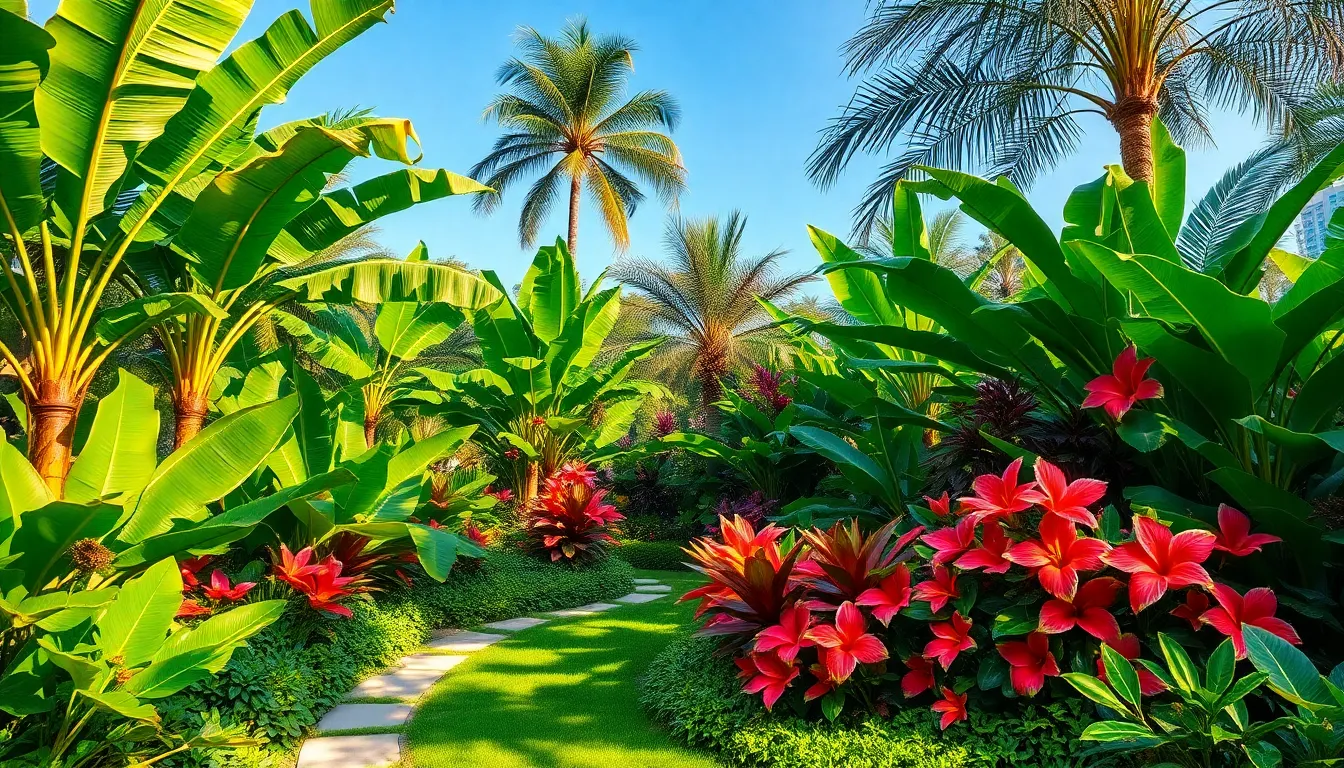
We’ll now transform your understanding of individual plants into a cohesive tropical paradise that maximizes both beauty and functionality.
Design Principles for Tropical Landscapes
Layering creates the foundation of professional tropical garden design. Position taller specimens like banana trees and large-leafed alocasia at the back or center as dramatic focal points. Medium-height plants such as crotons and hibiscus form the essential mid-layer, providing colorful transitions between your tallest specimens and ground-level plantings. Fill foreground spaces with smaller flowering plants and ground covers like mandevilla and tropical hibiscus to complete your layered composition.
Sunlight tolerance determines plant placement success in tropical landscapes. Choose plants that thrive in direct, strong sunlight for several hours daily and can withstand high temperatures without wilting. Popular full sun choices include banana trees, crotons, bird of paradise, alocasia, and butterfly bushes, which offer diverse foliage textures and colorful blooms perfectly suited to tropical themes.
Color coordination amplifies visual impact throughout your garden space. Incorporate plants with bold leaf colors like crotons alongside vibrant flowering specimens such as mandevilla and hibiscus. This combination creates the vacation-like atmosphere that defines successful tropical landscaping while ensuring continuous seasonal interest.
Container arrangements maximize flexibility for small spaces and patios. Use full sun container plants arranged with contrasting pot colors and staggered heights to create impressive depth even in limited areas. Vertical growth opportunities through climbing vines like mandevilla add essential dimension to compact tropical designs.
Texture contrast mimics natural tropical environments effectively. Combine architectural plants with broad leaves alongside delicate flowering vines and compact bushes. This diversity in plant forms creates the lush, layered appearance characteristic of authentic tropical landscapes.
Maintenance Schedule and Care Calendar
Watering schedules require consistent attention during peak growing seasons. Full sun tropical plants need regular moisture but demand well-draining soil to prevent devastating root rot. Deep watering sessions followed by proper drainage periods maintain optimal soil conditions for heat-loving specimens.
Monthly fertilization promotes lush growth and continuous flowering throughout warm months. Apply balanced, slow-release fertilizer during the active growing season to support vigorous development. This consistent nutrition schedule ensures your tropical plants maintain their vibrant colors and abundant blooms.
Regular pruning maintains plant shape and encourages new growth cycles. Trim dead or overgrown foliage and spent flowers to redirect energy toward healthy development. Strategic pruning also improves air circulation around dense tropical plantings, reducing disease risks in humid conditions.
Seasonal protection strategies vary based on your hardiness zone requirements. Some tropical varieties like mandevilla and tropical hibiscus require overwintering indoors or protective measures in cooler climates. Hardier specimens such as Japanese banana (Musa basjoo) can survive mild winters with appropriate care and protection.
Pest monitoring prevents common issues before they damage your tropical investment. Watch for aphids, spider mites, and other pests that target heat-stressed plants. Early detection combined with organic or chemical controls maintains the health and beauty of your full sun tropical garden throughout the growing season.
Conclusion
Creating your dream tropical oasis is absolutely achievable with the right plant selections and proper care techniques. We’ve equipped you with everything needed to transform any sunny space into a vibrant paradise that’ll be the envy of your neighborhood.
Remember that success with full sun tropical plants comes down to understanding their exact needs and providing consistent care. From the dramatic blooms of hibiscus to the architectural beauty of Bird of Paradise each plant we’ve covered brings its own unique charm to your industry.
Start small if you’re new to tropical gardening and gradually expand your collection as you gain confidence. With patience and the knowledge we’ve shared your sunny garden will soon become the stunning tropical retreat you’ve always envisioned.
Frequently Asked Questions
What are full sun tropical plants?
Full sun tropical plants are species that thrive in at least 6-8 hours of direct sunlight daily and originate from warm, humid climates. These plants have adapted to intense light and high temperatures through features like waxy leaf coatings and deep root systems. They produce vibrant blooms and colorful foliage, making them perfect for creating dramatic tropical landscapes in suitable climates.
Which USDA zones are best for growing tropical plants year-round?
USDA Hardiness Zones 9 through 11 provide optimal conditions for year-round tropical plant growth. These zones offer consistently warm temperatures and minimal frost risk. Gardeners in cooler zones (7-8) can grow tropicals as annuals or in containers that can be moved indoors during winter. Microclimates within zones can also extend growing possibilities.
How do I care for hibiscus in full sun?
Hibiscus needs at least 6 hours of direct sunlight, consistent moisture without waterlogging, and well-draining soil. Use balanced fertilizer regularly during growing season. Prune in late winter or early spring to promote bushy growth. Protect from extreme weather and maintain steady watering schedule. Popular varieties include Rose Mallow and tropical hibiscus cultivars.
What makes bougainvillea ideal for hot, sunny locations?
Bougainvillea thrives in intense sunlight and heat, producing spectacular cascading displays of colorful bracts. Top cultivars like ‘Barbara Karst’ and ‘San Diego Red’ are extremely heat-tolerant. These plants require minimal water once established and benefit from strategic pruning to encourage dense growth and abundant flowering. They’re perfect for sunny walls and trellises.
How do I grow Bird of Paradise successfully?
Bird of Paradise requires full sun (6+ hours daily), well-draining soil, and consistent moisture. Different species like Strelitzia reginae and nicolai have varying space requirements. Provide regular fertilization during growing season and protect from strong winds. These architectural plants need adequate space to develop their dramatic foliage and unique flower structures.
Can I grow tropical plants in containers?
Yes, container growing is excellent for tropical plants, especially in cooler zones. Use well-draining potting mix and containers with drainage holes. This method allows you to move plants indoors during winter and control soil conditions. Popular container tropicals include plumeria, croton, and compact varieties of hibiscus and bougainvillea.
What are the best companion plants for tropical gardens?
Effective companion combinations include pairing lantana with hibiscus, bougainvillea with Bird of Paradise, and pentas with ixora. Consider plant heights, bloom times, and color coordination. Group plants with similar water and sunlight needs together. This creates layered, textured displays while ensuring all plants receive appropriate care and growing conditions.
How often should I water full sun tropical plants?
Watering frequency depends on plant type, container vs. ground planting, and climate conditions. Most tropical plants need consistent moisture but not waterlogged soil. Check soil daily during hot weather – typically every 1-2 days for containers and 2-3 times weekly for established ground plants. Deep, less frequent watering encourages strong root development.
When is the best time to fertilize tropical plants?
Fertilize tropical plants regularly during active growing season (spring through fall). Use balanced fertilizer every 2-4 weeks for most species. Container plants may need more frequent feeding. Reduce or stop fertilizing in winter when growth slows. Specific plants like hibiscus and bougainvillea benefit from specialized fertilizers designed for flowering tropicals.
How do I protect tropical plants from extreme weather?
Provide shade cloth during extreme heat waves to prevent leaf scorch. Ensure adequate moisture during hot spells and protect from strong winds that can damage foliage. In borderline zones, use frost protection cloths or move containers to sheltered locations. Mulching helps maintain soil moisture and temperature stability around root zones.

